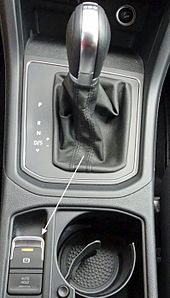Electric parking brake
The electric parking brake is a technology in motor vehicles that uses actuators on the rear wheel brake and a control unit to replace the conventional parking brake . The term EPB in its short form comes from English and is the abbreviation for Electric Parking Brake .
Depending on the car manufacturer, the EPB is also known under the name APB (Automatic Parking Brake), EFB (Electric Parking Brake ) or EMF (Electromotive Parking Brake) .
Automotive suppliers for electric parking brakes are: ZF TRW , Küster , Conti Teves , Brose Fahrzeugteile and Robert Bosch GmbH , which have now successfully integrated the EPB.
technology
The electric parking brake (EPB, sometimes also called APB - automatic parking brake -) replaces the mechanical parking brake in the automotive industry and is also known as the electric parking brake.
With the conventional parking brake , the driver operates a mechanical device with his foot or hand, which generates a locking force on the rear brake system via cables. The operator generates an individual mechanical force with an actuation unit (hand or foot operated). This is transmitted to the rear brake system via mechanical cables. Here a force is exerted on the brake disc or drum. In the case of very heavy vehicles, a separate drum brake is often used in order to achieve the necessary holding forces.
Three systems are currently available for the electric parking brake . What they all have in common is the replacement of the mechanical operating lever with an electrically switching operating unit.
Cable puller system
An actuator (motor-gearbox unit, usually with an integrated electronic control) tensions the mechanical cables, which then generate the tensioning force in the rear brake system as with the conventional parking brake. The advantage of this system is that the EPB can be integrated into an existing vehicle structure, since the installation space can be freely selected and this system works with both drum and disc brakes.
Motor on Caliper System
This is a system in which additional small motor-gear units (also called direct actuators) mounted directly on the brake caliper actuate the brake pistons of the rear brake calipers and thus generate the necessary locking force. There are no more cables in this system. The system is very easy to integrate into a vehicle, but only works with disc brakes.
Electric drum brake
This system is used for very heavy vehicles. A motor-gear unit activates a separate drum brake that generates the clamping force. With this system there are no longer any cables.
functionality
The electric parking brake is a further step in the implementation of a fully electric braking system. With their help, it is possible to implement additional comfort functions, such as assisted starting on the hill . This function can also be made possible by other driver assistance systems.
A handbrake lever or handle, including a Bowden cable , which is usually located in the center console of a vehicle, is completely dispensed with . The EPB is operated via a button and thus opens up new possibilities for vehicle manufacturers in the design of the interior.
Benefits and advanced features
Vehicle interior design:
- Replacement of the hand lever with a freely configurable electrical control unit, the vehicle interior can be designed individually
- new freedom for the center console
Redundant braking system (dynamic state) with additional fall-back levels:
- Actuation of the electric parking brake while driving (safe dynamic deceleration over all four wheels)
- Very safe braking even in poor conditions
Security functions:
- automatic retensioning (hot brakes lead to a loss of clamping force with a mechanical parking brake, i.e. the braking force decreases in the cooling phase. The electric parking brake compensates for the loss.)
- the vehicle is always parked with maximum clamping force (always safe - with a mechanical parking brake, the driver determines the holding force - incorrect operation due to insufficient braking force is excluded)
Comfort functions:
- automatic release when starting (drive away release - DAR)
- automatic closing of the parking brake when removing the ignition key (Key out apply - KOA)
Advanced features:
- Auto-hold function (the parking brake is automatically activated when the vehicle is stationary)
- Additional function (prevents the vehicle from rolling away unintentionally)
Maintenance-free:
- The cable EPB compensates for the wear on the brake linings, so maintenance is not required
disadvantage
- Decoupling of the driver and the associated loss of control and function
- Pull-in and release times at 1 second, which is slightly slower than a manual parking brake
- Total failure of the function if the electrical power supply fails.
- higher complexity
- Costs, whereby the cost of the electric parking brake is getting closer and closer to that of the conventional handbrake due to the increasing spread in the market
- "Gentle" release not possible or dependent on programming, which makes starting on slippery surfaces very difficult.
- Systems that work with additional motor-transmission units mounted directly on the brake caliper increase the unsprung masses on the wheels concerned.
- Brake cannot be used to drift the vehicle
literature
- Karl-Heinz Dietsche, Thomas Jäger, Robert Bosch GmbH: Automotive pocket book. 25th edition, Friedr. Vieweg & Sohn Verlag, Wiesbaden 2003, ISBN 3-528-23876-3 .
- Hans-Hermann Braess, Ulrich Seiffert: Vieweg manual automotive technology. 2nd edition, Friedrich Vieweg & Sohn Verlagsgesellschaft mbH, Braunschweig / Wiesbaden 2001, ISBN 3-528-13114-4 .
Individual evidence
- ↑ http://www.audi.ch/ch/brand/de/tools/advice/glossary/elektromechanische.browser.html Linking EFB with ESP and ABS using the example of Audi
- ↑ http://www.opel-blog.com/2011/04/21/sicherheit-per-tastenzug/ EPB and ESP using the example of Opel
Web links
- Electronic parking brake systems from Continental
- EPB from TRW Automotive
- KÜSTER Automotive GmbH
- Mechatronic assembly using the example of the electric parking brake - Overview of electronic parking brakes from various manufacturers - p. 19 Vehicle integration, p. 27 Dynamic mode (TRW / TU Dortmund, PDF; 4.5 MB)
